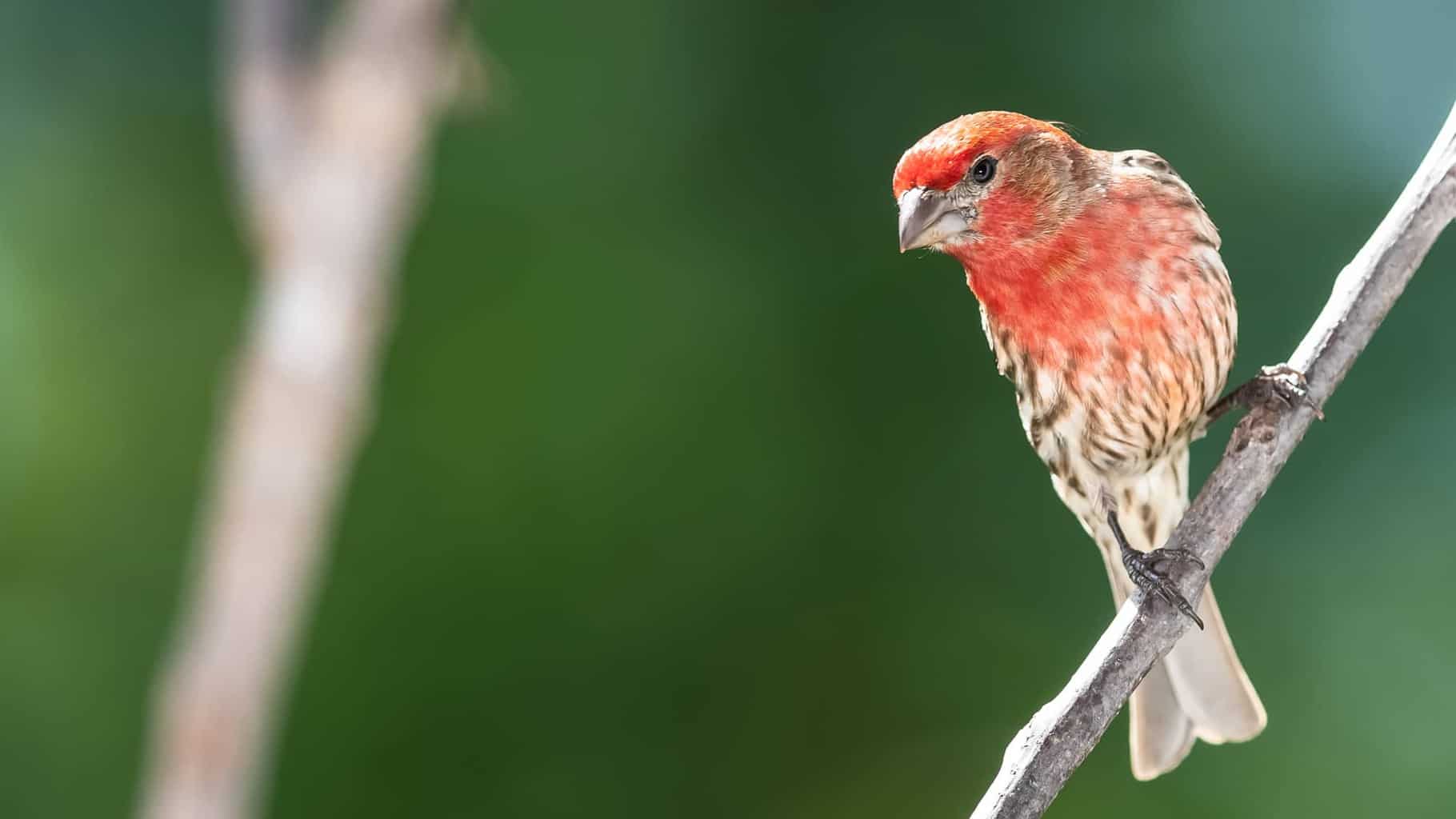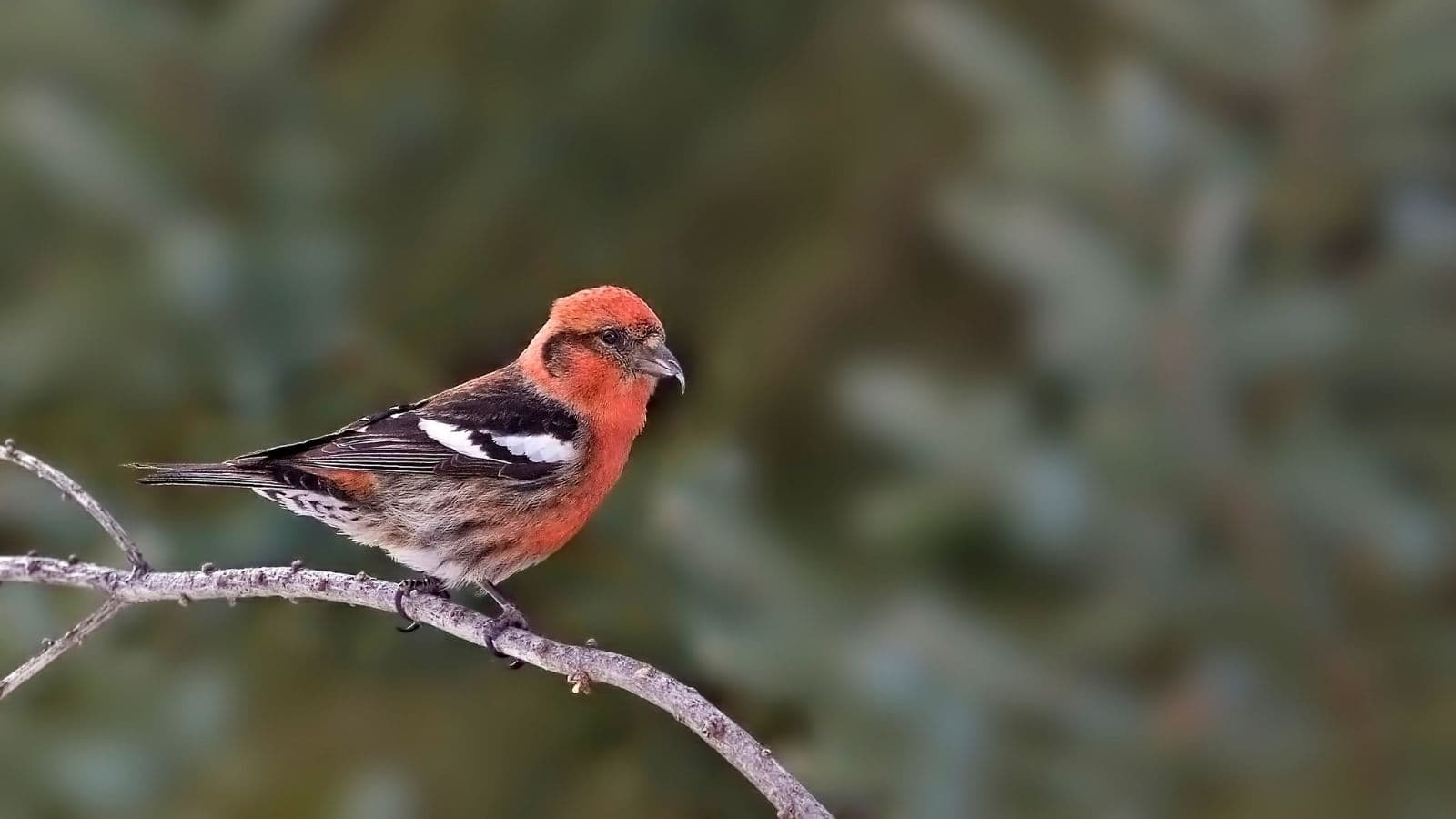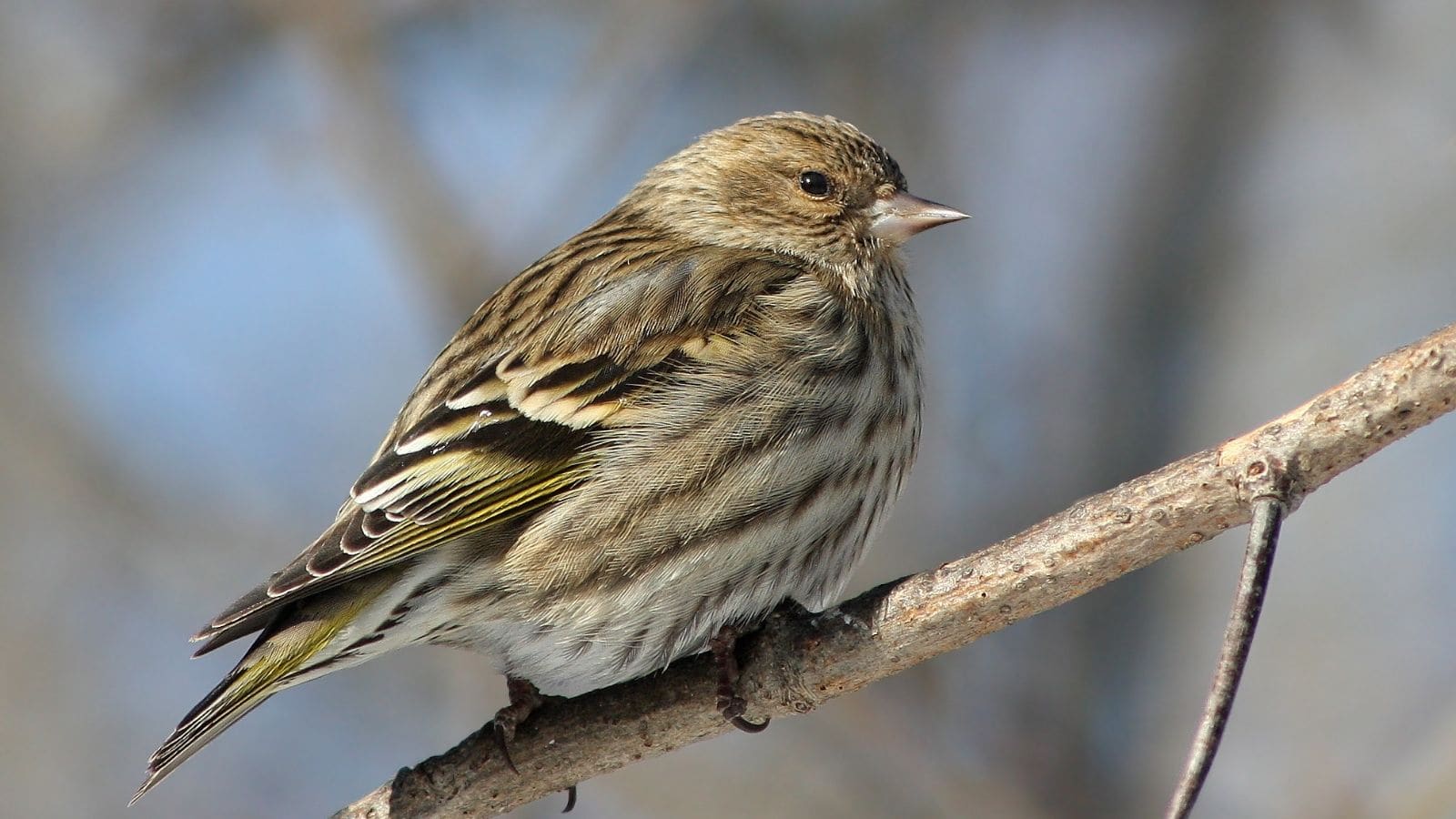Missouri’s state bird is the eastern bluebird, a migratory thrush covered in a mantle of bright blue which contrasts with its russet breast that blends into a white undersurface.
Kansas’ eastern neighbor is also home to the northern harrier (recognizable by its rather refined profile and the beautiful bronze and white patterns of its undersurfaces and wings) as well as what is quite possibly one of the most striking corvids, the bluejay.
There are 437 bird species in Missouri. While over fifty are considered accidental, several are either migrants or visitors or simply call this midwestern state home.
Included in that category are passerines, and here, Missouri’s beautiful finches have been examined to find out where they may be found in the state, and when.
Evening Grosbeak

- Scientific Name: Hesperiphona vespertina
- Length: 6 – 9 inches
- Weight: 1.4 – 3 ounces
- Wingspan: 12 – 14 inches
Male evening grosbeaks are a striking blend of colors. There’s the dark brown covering their heads, the bold yellow in a band above their eyes, and the mustard of their upper and under surfaces. Those three colors are further accentuated by the striking contrast of their wing feathers, which form a white wedge at the center of each wing surrounded by a thickened black border.
Female evening grosbeaks are however gray with hints of yellow at the neck. Both genders also have large bold beaks with which they crack kernels open.
Members of this species have a sweet tooth and are rather fond of apples, crabapples, cherries, and juniper fruits. They also indulge in insects for a protein-rich boost during nesting season and are also very fond of ash, box elder, maple, and tulip seeds.
They can be seen in Missouri tucking away sunflower seeds at backyard feeders in winter. During those cold season visits caused by a shortage in pine cone seeds in Canada, they can be seen throughout the state.
Pine Grosbeak

- Scientific Name: Pinicola enucleator
- Length: 9 inches
- Weight: 2 – 3 ounces
- Wingspan: 13 inches
Pine grosbeaks are known for their large sizes which makes the males especially striking in their red plumage. They are also known for their ability to keep a cool head with humans in close proximity.
In addition to that dark red plumage, male members of the species also have gray and black wing feathers that whiten at their edges. Their female counterparts are covered in gray plumage which turns bronze at their heads.
Like evening grosbeaks, pine grosbeaks are rather partial to crabapples. They are also fond of berries as well. These large finches also take full advantage of those warm summer months during which they enjoy insects too. They are also partial to seeds including those of conifers, grasses, and weeds, and enjoy visiting birdfeeders to help themselves to sunflower seeds.
Although they can be found in Canada and western America for the most part, they may move southwards from the north owing to a shortage in conifer seeds.
However, the furthest border of their southernmost winter range lies at Lake Erie’s southern shores, far to the north of Missouri. As a result, any members of this species seen that far south are likely to be accidental visitors.
Black Rosy-Finch

- Scientific Name: Leucosticte atrata
- Length: 6.5 inches
- Weight: 2 – 3 ounces
- Wingspan: 13 inches
Black rosy-finches are covered in plumage which is predominantly brown but flushed with pink at their undersurfaces and wings. However, their coloring turns gray at the upper half of their heads and black at their foreheads.
This species is something of an omnivore and its members will tuck away insects when the opportunity arises. However during winter black rosy-finches generally switch to a vegetarian diet and focus on seeds, buds, and leaves. They are also fond of salt.
These passerines are at home in alpine snowfields and the barren tundra where they breed. They are rarely found in Missouri which lies far to the east of their usual range in the west (and includes Idaho, Wyoming, Montana, Nevada, and Utah).
House Finch

- Scientific Name: Haemorhous mexicanus
- Length: 5 – 6 inches
- Weight: 0.6 – 0.9 ounces
- Wingspan: 8 – 10 inches
House finches are covered in brown stripes at the flanks and chest and are generally a mild brown, overall. However, the heads and chests of males are also covered in a bold red hue thanks to the presence of a pigment obtained from their food. Occasionally that additional flush of color may be orange, or even yellow.
House finches prefer to eat berries, buds, flowers, and insects. They are rather gregarious at feeding times and love to visit bird feeders in the company of their relatives.
Although they were originally confined to the west of the United States, they were unable to move to the east. However, in the early 20th century, pet sellers brought them to New York, where they were sold. Some however were let loose, survived, and proliferated.
Today, house finches can be found in every state in the contiguous United States including Missouri. The only exceptions include Florida’s southernmost tip as well as Texas’ Gulf Coast.
Purple Finch

- Scientific Name: Haemorhous purpureus
- Length: 4.7 – 6.3 inches
- Weight: 0.63 – 1.10 ounces
- Wingspan: 10 inches
While purple finches certainly resemble house finches, they have quite a few distinguishing features that can be used to tell them apart:
One of the most common of these is the coloring in males. Purple finches which are male are covered at the face, throat, breast, and even upper surface in a reddish purple. The red pigment of male house finches is sharper and is tinged with orange.
Female purple finches are also covered in streaks which are bolder and darker compared to female house finches. Purple finches also have shorter forked tails compared to house finches, which have longer tails with forks that are less noticeable.
These granivores are rather partial to seeds and buds from trees such as ash, elms, juniper, maple, and red cedar. They are also fond of blackberries, grapes, raspberries, as well as sumac berries, and feed on caterpillars and beetles.
Purple finches only visit Missouri in winter when they may be found throughout the state. However, they can be found all year round on the Pacific Coast as well as further east in New York, Vermont, Connecticut, and Maine.
Common Redpoll

- Scientific Name: Acanthis flammea
- Length: 4.5 – 5.5 inches
- Weight: 1.12 ounces
- Wingspan: 8 – 9 inches
These diminutive hardy finches breed in Canada where they also spend most of their time. They possess a red cap, striped wings, and upper parts in dark brown and white. Their underparts, however, are white, striated with brown.
Common redpolls are especially fond of alder and birch seeds, although they also enjoy eating the seeds of several weeds, and insects. The presence of a throat pouch enables them to feed efficiently in inclement weather. Once they store sufficient quantities of food, they simply head for a suitably sheltered spot and digest their hastily eaten meal while at rest.
These restless passerines do not frequently visit Missouri but may do so during winter. When present they may be found in the upper two-thirds of the state which forms part of their southernmost winter range.
Hoary Redpoll

- Scientific Name: Acanthis hornemanni
- Length: 5 – 5.5 inches
- Weight: 0.40 – 0.50 ounces
- Wingspan: 8 – 10 inches
Members of this species may be considered common redpoll lookalikes. However, they are paler overall with less streaking on their plumage.
Although they share their close relatives’ fondness for alder, birch, and willow trees, they are capable of tolerating even harsher conditions compared to common redpolls. As a result, they breed on Canada’s Arctic islands.
Hoary redpolls rarely visit Missouri. Their winter range lies in Canada and its southernmost limits include parts of Montana, North Dakota, Idaho, and Wisconsin, as well as New York, Connecticut, and Maine, in their entirety.
Red Crossbill

- Scientific Name: Loxia curvirostra
- Length: 7.5 inches
- Weight: 2 ounces
- Wingspan: 12 inches
Rather gregarious, and talkative, red crossbills love nothing better than searching for food in the company of members of the same species.
Male members are colored in a sharp red hue while their wings and tails are brown. Females on the other hand are grayish brown while their heads and chests are olive-hued.
Mature adults have dark beaks that are crossed at their tips – a feature absent in youngsters.
Red crossbills prefer coniferous woodland where pine cones are in abundance. They however have to keep a sharp lookout for sparrowhawks which consider them a tasty treat.
Red crossbills live in Canada and the western United States all year round. They can similarly be found in the eastern United States in a small segment that straddles the borders between West Virginia and Virginia, and Tennessee and North Carolina.
On occasion, they may winter in the rest of the United States and may be found throughout Missouri as a result.
White-Winged Crossbill

- Scientific Name: Loxia leucoptera
- Length: 5.7 – 6.7 inches
- Weight: 0.9 – 1.40 ounces
- Wingspan: 11 inches
The second of the three crossbill species in the United States, (the third is the Cassia crossbill), white-winged crossbills can be recognized by their bright red coloring if they are males. Females are covered in dark brown streaks at the chest and abdomen.
Both genders have darker wings with two white wing bars. Males’ wing feathers are black while those belonging to females are brown. Irrespective of their gender, white-winged crossbills have a powerful bill crossed at their tips for prising cones open.
Members of the species mainly live on a diet of conifer seeds including those of hemlock, tamarack, and spruce trees. They also nest in conifer forests and are often found there, as a result. White-winged crossbills are also fond of eating berries, buds, and arthropods.
These crossbills live further to the north in Canada and most of Maine. However, they only travel south during those winters when there’s insufficient food in their range.
During such irruptions, they can be found in northern Missouri, which is included in their southernmost range.
Pine Siskin

- Scientific Name: Spinus pinus
- Length: 4 – 5.5 inches
- Weight: 0.40 – 0.60 ounces
- Wingspan: 7 – 9 inches
Pine siskins are covered in a striated pattern, and have dark wing feathers which end in yellow at their tips creating a contrasting scalloped effect.
They also have small delicately tapered beaks which are a dark gray, as well as black eyes.
These finches can be found throughout Missouri during winter, as is the case for every state in North America. They prefer to breed in Canada. However, permanent populations can be found in the western United States and Vermont and New Hampshire all year long.
Lesser Goldfinch

- Scientific Name: Spinus psaltria
- Length: 3.5 – 5 inches
- Weight: 0.3 – 0.4 ounces
- Wingspan: 6 – 8 inches
The upper surfaces of male lesser goldfinches are predominantly covered in black wings with individual feathers featuring gray and white edging, creating a marked contrast. These finches are also olive at their napes and mantles and sport black caps at their crowns. Their undersurfaces, however, are a bold yellow.
Female lesser goldfinches are similar in color although they lack the striking black crown of their male counterparts; their undersurfaces are a more muted yellow.
Both genders have bold conical beaks with which they consume seeds, their favorite foods.
Lesser goldfinches can be found in wooded areas, trees close to water, and open areas with weeds. However, they generally avoid heavily forested areas. They are rather gregarious and talkative and are fond of foraging in each others’ company. They are especially partial to berries, buds, daisy seeds, sunflower seeds, and thistle seeds, as well as flowers.
They are rarely found in Missouri since they are mostly found in the western and southwestern United States all year round.
American Goldfinch

- Scientific Name: Spinus tristis
- Length: 5.5 inches
- Weight: 0.4 – 0.7 ounces
- Wingspan: 8 – 9 inches
The appearance of this species of goldfinch depends not just on its gender but what time of the year it is. During the breeding season, males are covered in a glorious lemon yellow infused with hints of white. The black at their foreheads and their wing feathers (streaked with white), complete the alluring ensemble. Their feet and legs are pale pink, while their tapered beaks are also golden.
The colors of females are more muted and consist of yellow-brown on their upper and lower surfaces and olive at the head. Their wings are similar to those of males, although their beaks are gray.
By the time it’s winter, both genders look a lot more like each other having swapped their summer attire for a more subdued olive.
These goldfinches are often found in the company of pine siskins nimbly negotiating thistles in order to feed on their seeds. They may also be found on alder, birch, or elm trees which also serve as sources of food.
American goldfinches live in every part of Missouri all year round.
Conclusion
Finches are a key part of North America’s fauna, and as a result, it’s no surprise to find that quite a few of them can be spotted in Missouri.
Although certain species are rather rare winter visitors such as common and hoary redpolls, others such as red crossbills, purple finches, and pine siskins are regulars during the season.
Certain species, such as American goldfinches and house finches, however, call Missouri home and can be admired all year long, regardless of what season it is.

